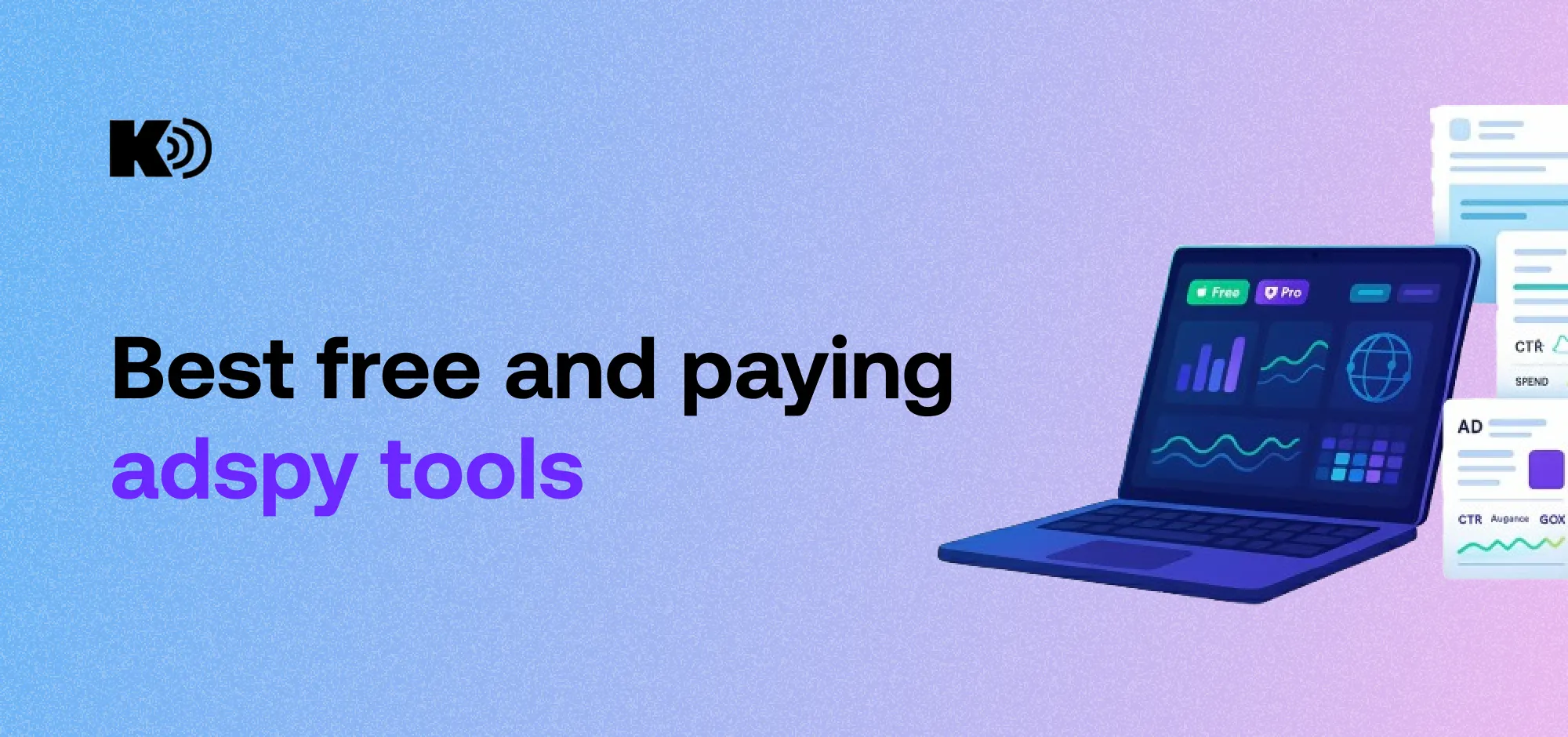How Do I Increase Shopify Conversion Rate? (25 Tips For 2025)
If your Shopify store isn’t converting visitors, you’ll face high acquisition costs and poor ROI. To avoid those issues, you need to increase your Shopify conversion rate.
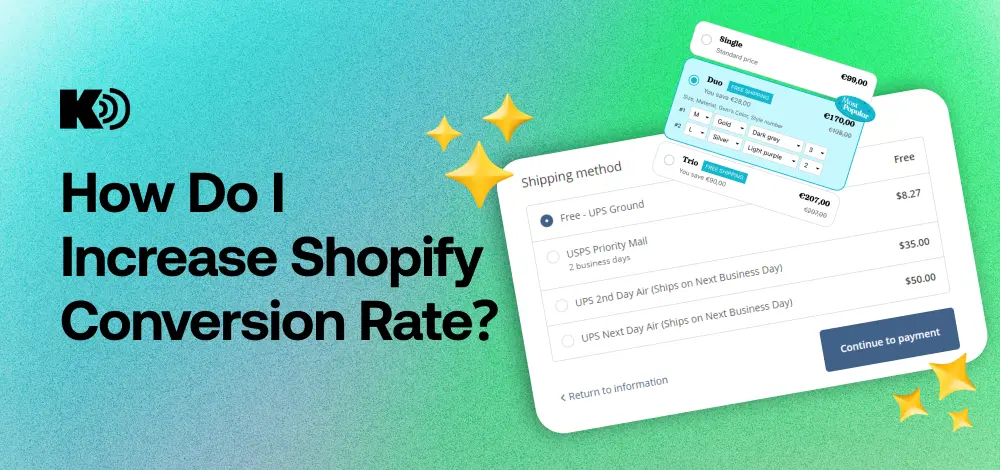
This post reveals 25 of the most effective conversion rate optimization (CRO) strategies in e-commerce. But before you choose the best tactics for your store, you need to understand the basics. Here’s a quick refresher:
Conversion rate (CVR) is the percentage of website visitors who complete a desired action, such as making a purchase or signing up for a free trial. This is the general formula for calculating it:
CVR = (Number of conversions / Number of visitors or sessions) x 100
Conversion rate optimization (CRO) is the strategic process of increasing the percentage of visitors who take a desired action. It’s the act of improving conversions without necessarily increasing the number of visitors.
For most Shopify store owners, the most important conversion (desired action) is completing checkout. However, some businesses may prefer to focus on other types of conversions, such as newsletter sign-ups, service subscriptions, free trial sign-ups, affiliate clicks, or cart creation.
What is a Good Conversion Rate?
A "good" conversion rate varies by industry and business, but a general benchmark is between 2% and 5% for overall websites, with anything above 5% considered excellent. You should aim for a minimum of 2% and use CRO strategies to grow this number.
The average conversion rate for Shopify stores is 1.4%, according to a report by LittleData. However, the actual numbers vary by industry: fashion averages 1.9%, while finance is much lower at 0.2%.
25 Best Tips to Increase Shopify Conversion Rate That Work in 2025
There are countless ways to boost site CVR, but I’ll focus on the most effective options. All 25 tactics in this post will help you achieve the following goals, which are vital for conversion rate optimization on Shopify:
- Improve store offer clarity and reduce distractions
- Increase brand trustworthiness
- Drive urgency at checkout and reduce abandoned carts
- Increase the appeal of your products
- Identify problems in your funnel
A. Store Design & User Experience (UX/UI)
1. Use a clean, fast, and mobile-first Shopify theme
According to recent studies, 64.04% of all your traffic will likely come from mobile devices, especially if you’re into B2C ecommerce. If you can’t provide a seamless shopping experience to two-thirds of your visitors, you’ll lose out on many sales.
To keep the majority of your customers satisfied and boost your conversion rate, you may need to improve the mobile usability of your site. (un)Common Logic recently shared details of how switching to a mobile-first design boosted conversions and increased sales by 70% for a B2C ecommerce company.
Before
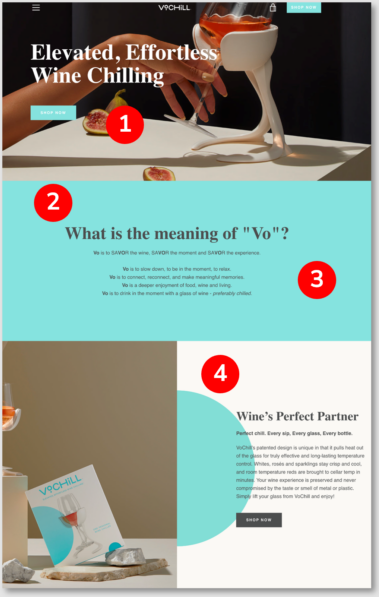
After
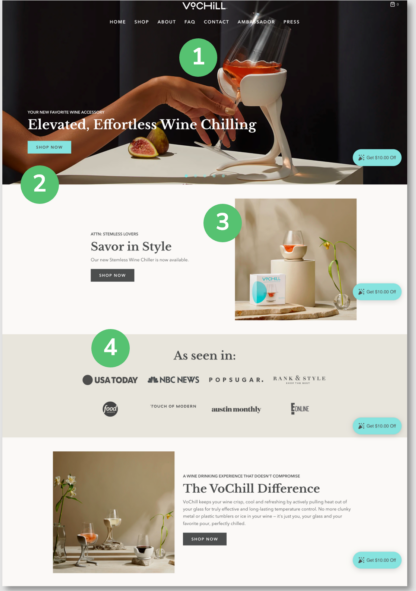
Start by using a clean, responsive, and mobile-friendly Shopify theme. Browse the Shopify Theme Store to find a wide variety of free and paid options. A mobile-first theme has the following characteristics:
- Fast load times
- Smooth and intuitive navigation
- Clickable elements
- Optimized images
2. Optimize product page layouts for scannability (titles, bullet points, tabs)
When customers visit a product page, they want to know more about the item they intend to buy. Your job is to feed them this information as clearly as possible. Too many distractions or a lack of clarity could chase them away.
You need to keep your product descriptions short, clear, and concise. Use titles, headings, and bullet points to highlight key benefits and features. Avoid confusing language when passing vital info, such as return policies. Also, be sure to use high-quality images and videos.
For your reference, observe how Apple optimized the product page for the iPhone 17 pro by using concise texts, quality images, and intuitive tabs.

3. Improve navigation with smart menus & product filters
Seamless navigation allows visitors to find the products they want without stress. By reducing friction, you make it easier for leads to move from product pages to thank you pages, thereby improving your conversion rate. Think of the simple but large menu options on the official Nike store.
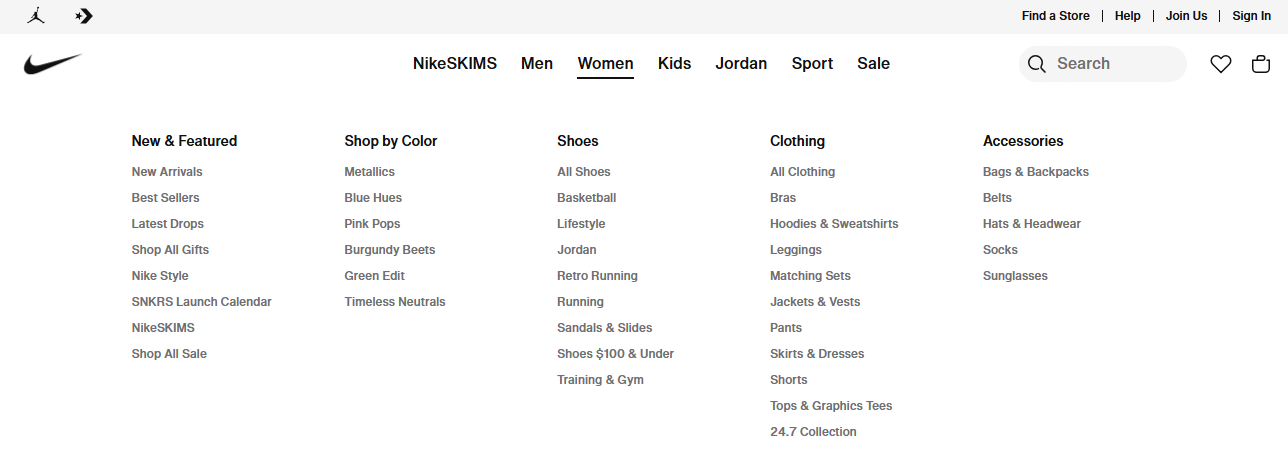
One of the best ways to improve site navigation is to use smart menus and product filters. The most basic approach is to display all product categories and subcategories in a mega menu or add a store search feature. If you have the resources, you can even add filters to your store’s search functionality.
4. Add trust badges and social proof near CTAs
A recent Baymard study showed 19% of US shoppers who abandon their carts do so because they didn’t trust the site with their credit card info. The more your site conveys trust, the easier it is to turn visitors into customers.
Use these social proof elements to build credibility:
- Authentic customer reviews and ratings
- Trust badges
- Testimonial videos
- Endorsements from influencers in your industry
- Relevant certifications
Since shoppers are most anxious just before taking a significant action, you want to use those elements close to CTA (Call-to-Action) buttons. Look how close EasyLlama places trust badges to its CTA button.

5. Use heatmaps to identify UX bottlenecks
Heatmaps are digital snapshots of clicks, scrolls, and mouse movements users make on your website during their sessions. They offer insights into how visitors interact with your site. With that, you can tell what tends to happen before a sale or before a lost conversion.
Heatmaps are powerful tools for A/B testing new UX design variations. You can also use them to catch bottlenecks such as site usability issues. Error or dead clicks are often signs that your users are confused or frustrated by an element. The issue may be a result of site bugs, broken links, or misleading UI designs.
Kids' fashion brand Sunuva was losing 38% of its buyers due to an erroneous notification that appeared on the checkout page.
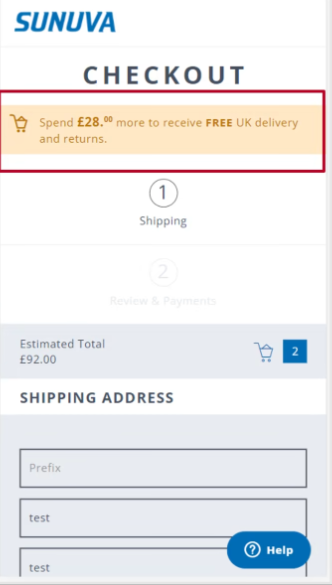
Heatmaps allowed their team to identify and remove the bottleneck, leading to more completed transactions.

B. Product Pages & Descriptions
6. Try product bundling
One of the best ways to increase conversion rate on Shopify is to simply give visitors an offer they can’t refuse, with the help of product bundles. Bundling is the strategy of combining two or more related items into one package and selling it at a discount.
Generally, product bundles help businesses to increase average order value. But they can also be excellent tools for boosting conversion rates. Health and wellness brand Vistevas discovered the CRO powers of bundles when the company boosted their conversion rate by 20% after offering quantity breaks. Apparently, people love freebies, and when you market your bundle as a free gift or volume discount, it can serve as a strong incentive.
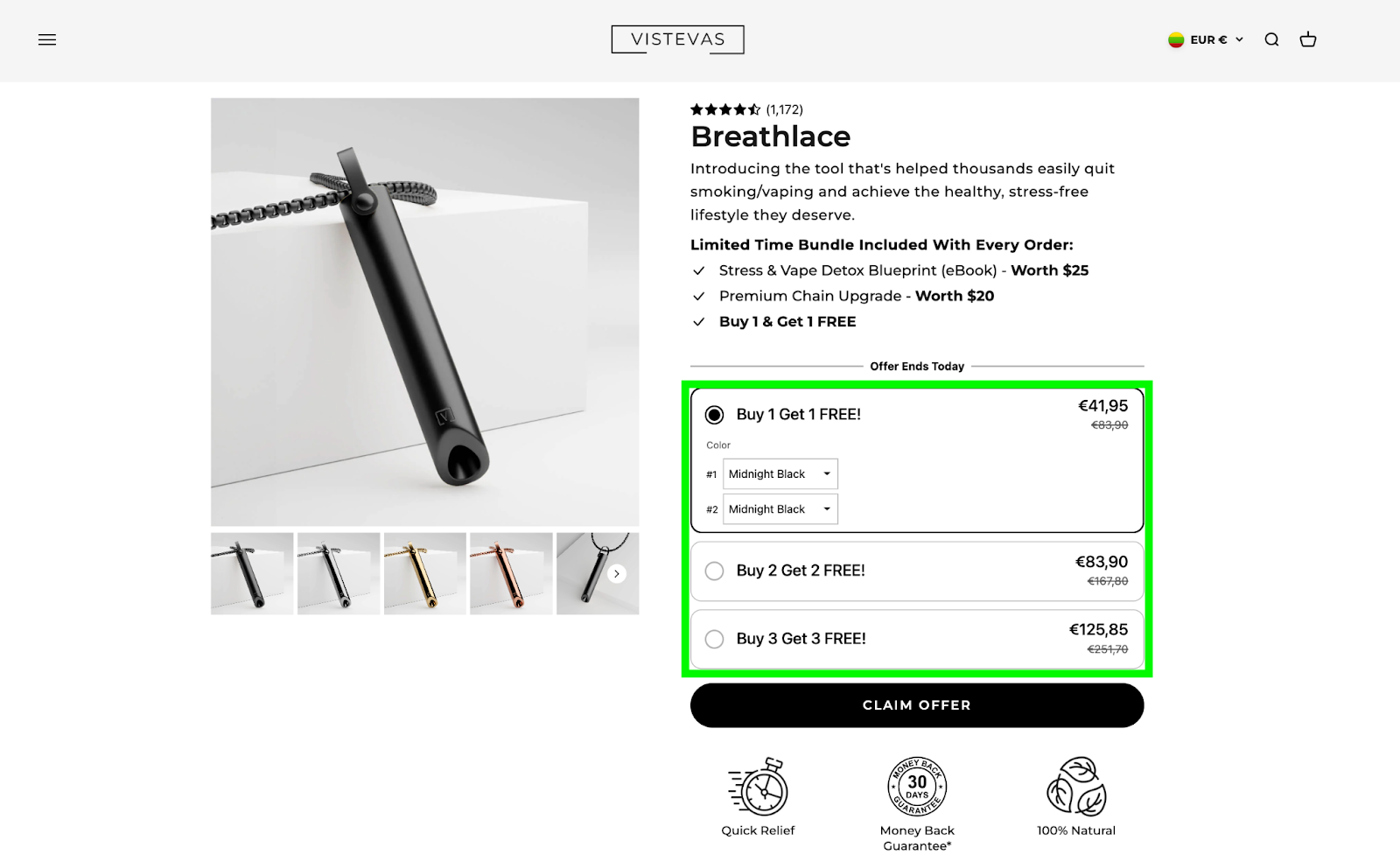
Like Vistevas, you should use a Shopify bundle upsell app that seamlessly integrates with any store, offers a non-intrusive user interface, and provides A/B testing.
7. Use high-quality photos and supplementary graphics
The average buyer in 2025 wants to know exactly what they’re getting before taking action. Since digital stores lack physical interaction, the next best thing is to display high-quality images.
Showing products from different angles is a cheat code for increasing conversion rate. To lower buyer hesitation even further, you can highlight key features, details, and textures using supplementary graphics. Ray-Ban offers a virtual try-on feature that allows customers to see exactly how the glasses will look on their faces.
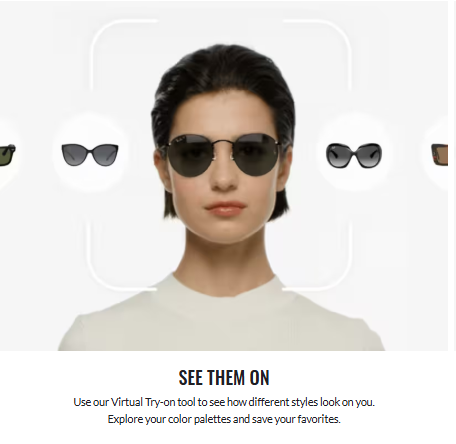
Here are some tips for creating high-quality images and graphics for your store:
- Hire a professional photographer or buy quality photography equipment
- Keep graphics consistent across your store
- Take 4-5 shots of each product variation (by color or style), showing it from different angles
- Give users the option for zoom and 360-degree view
- Create infographics to convey complex product features or specs
8. Include customer reviews, UGC, and star ratings above the fold
Sometimes a little extra credibility is all you need to persuade more visitors to take action. 93% of shoppers read customer reviews before making a purchase, and 73% trust those reviews. So, it makes sense to add customer reviews and star ratings to your store. You can also incorporate other forms of user-generated content (UGC), such as social media posts, videos, testimonials, blogs, and podcasts.
E-commerce beauty brand Sephora uses UGC videos on product pages and site galleries to build authenticity.

9. Add comparison charts (size, color, bundles) to reduce decision friction
Too many size, color, and bundle variations on a product page can cause decision friction and turn customers away. According to the popular psychology book The Paradox of Choice, offering choices boosts customer satisfaction, but too many choices can lead to inaction.
A comparison chart is a visual tool that shows the differences and similarities between two or more items (product/bundle variations in this case). By providing clear visualization, they help users make informed decisions faster and easier. Comparison charts are especially useful for fashion brands that offer various product sizes. Below is an example of Nike’s size comparison chart for men.

10. Use AI-generated personalization for product recommendations
By displaying product recommendations that resonate with visitors, you can upsell or cross-sell them and increase revenue plus conversion rate.
A dedicated AI tool allows you to tailor recommendations to individual interests using trackable data. Essential data points to track include:
- Browsing patterns
- Purchase history
- Pages visited
- User preferences
- Time on page
- Items viewed
Signet Jewelers used AI personalization to boost conversion rate by 88.6%. They showed a different engagement ring product listing page (PLP) to visitors with a spending history on sustainable products.

Default PLP (left) and personalized PLP (right)
We highly recommend that you browse through our list of the best Shopify upsell tools. Several of them offer targeted product recommendations.
C. Checkout & Cart Optimization
11. Enable one-page checkout
Too many steps in your checkout may be costing you conversions. It’s always a good idea to make checkouts as seamless as possible. And it doesn’t get more seamless than Shopify’s one-page checkout. Use it to collect only the information required to process an order, and you should see an uptick in completed transactions and conversion rate.
Hemlock & Oak boosted conversion rate by 7% after enabling Shopify’s one-page checkout.
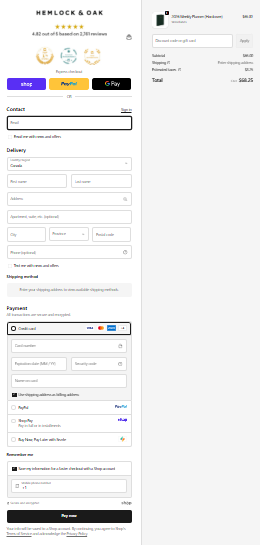
Pro Tip: Increase revenue by offering one-click post-purchase upsells right after checkout. The customer will still be in buying mode.
12. Add guest checkout option to reduce friction
If users have to create an account before shopping in your store, you’re alienating potential customers. Reduce friction and improve user experience by enabling guest checkout. And don’t worry about missing out on return business. You can give them the chance to create an account after a completed purchase.
Creative Market was losing 77% of customers who were prompted to sign up until they added the guest checkout option.

13. Show progress indicators in multi-step checkout
Uncertainty and lack of guidance are two of the leading causes of anxiety in online shoppers. According to the same Baymard study we mentioned earlier, 18% of shoppers who abandoned their carts did so because they found the checkout process too long or complicated. Hence, you can improve conversion rate by showing users exactly where they are in the checkout process and what comes next.
Break your process into clear steps and show progress with a visual indicator. Here’s a look at how Etsy used a progress indicator in their checkout designs:
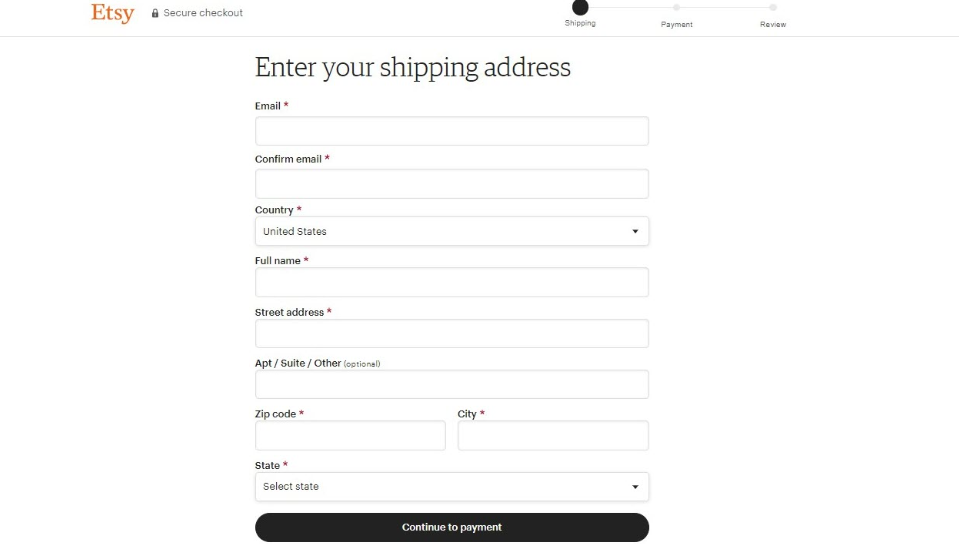
14. Offer multiple payment methods (PayPal, BNPL, Apple/Google Pay)
The last thing you want is to lose visitors who have money to spend but no way to spend it on your store. Ease the process of completing purchases by offering multiple payment options.

Here’s a list of the most common payment methods on Shopify stores:
- Credit and debit cards: Mastercard, Visa, etc.
- Online payment systems: PayPal, Stripe, etc.
- Bank transfer: ACH, SWIFT, wire, etc.
- Mobile wallets: Apple Pay, Google Pay
- Buy Now Pay Later (BNPL) merchants: Shop Pay Installments, Klarna, Afterpay, etc.
Be sure to display all of the available payment methods on your cart and checkout pages.
15. Use cart abandonment popups/emails with incentives
One sure way to increase conversions is to recover abandoned carts. You need to engage customers who don’t complete their purchase and persuade them to get back on track. You can display cart abandonment popups as a preventive measure or send out emails to customers.
Eldorado.ua, a European electronics retailer, saw a boost in conversions after introducing an exit-intent pop-up to recover carts.

Here are some effective tips to remember:
- Display exit intent popups as a reminder of items left in the cart
- Show exclusive offers to users who have left items in their cart for a specific period
- Send emails to remind customers of items left in the cart
- Offer perks like free shipping, discounts, or guarantees in popups and emails
- Convey urgency in your copy
D. Pricing, Offers & Incentives
16. Experiment with psychological pricing (e.g., charm pricing, tiered offers)
Sometimes a small change in pricing structure is all you need to boost conversions on your site. Psychological pricing is a strategy that utilizes consumer psychology to influence purchasing decisions. The most common example is displaying a $10 price tag as $9.99. Let’s explore some helpful options:
- Charm Pricing: Setting the price just below a round number to make products seem significantly cheaper. For example, displaying a $10 price tag as $9.99.
- Tiered Pricing: Creating premium tier offers and highlighting their most attractive benefits.
- Innumeracy: Revamping the wording of your offers to make them appear more valuable. For instance, instead of saying “25% discount when you buy two units,” say “buy one and get one for 50% off.” Both statements mean the same thing, but a 50% discount sounds more appealing than a 25% discount.
Use A/B testing with Kaching Bundles Quantity Break Shopify app to figure out which tactics cause the highest increase in conversion rate.

17. Offer volume discounts to raise AOV
Volume discount is a promise to provide a reduced price per unit for a product. You can offer it in the form of tiers. For instance, 1-10 units are at full price, 11-20 units receive a 5% discount, and 21+ units get a 10% discount. By doing that, you’re giving visitors one more reason to buy from you instead of your competitors. Volume discounts also help you increase your average order value (AOV).
US-based shipping brand Flush Packaging used volume discounts to increase AOV by 23%. If you want to achieve similar results, use price per unit and price comparisons to help customers understand the value they get at different volumes. We recently posted an article on the best Shopify apps with volume discounts.
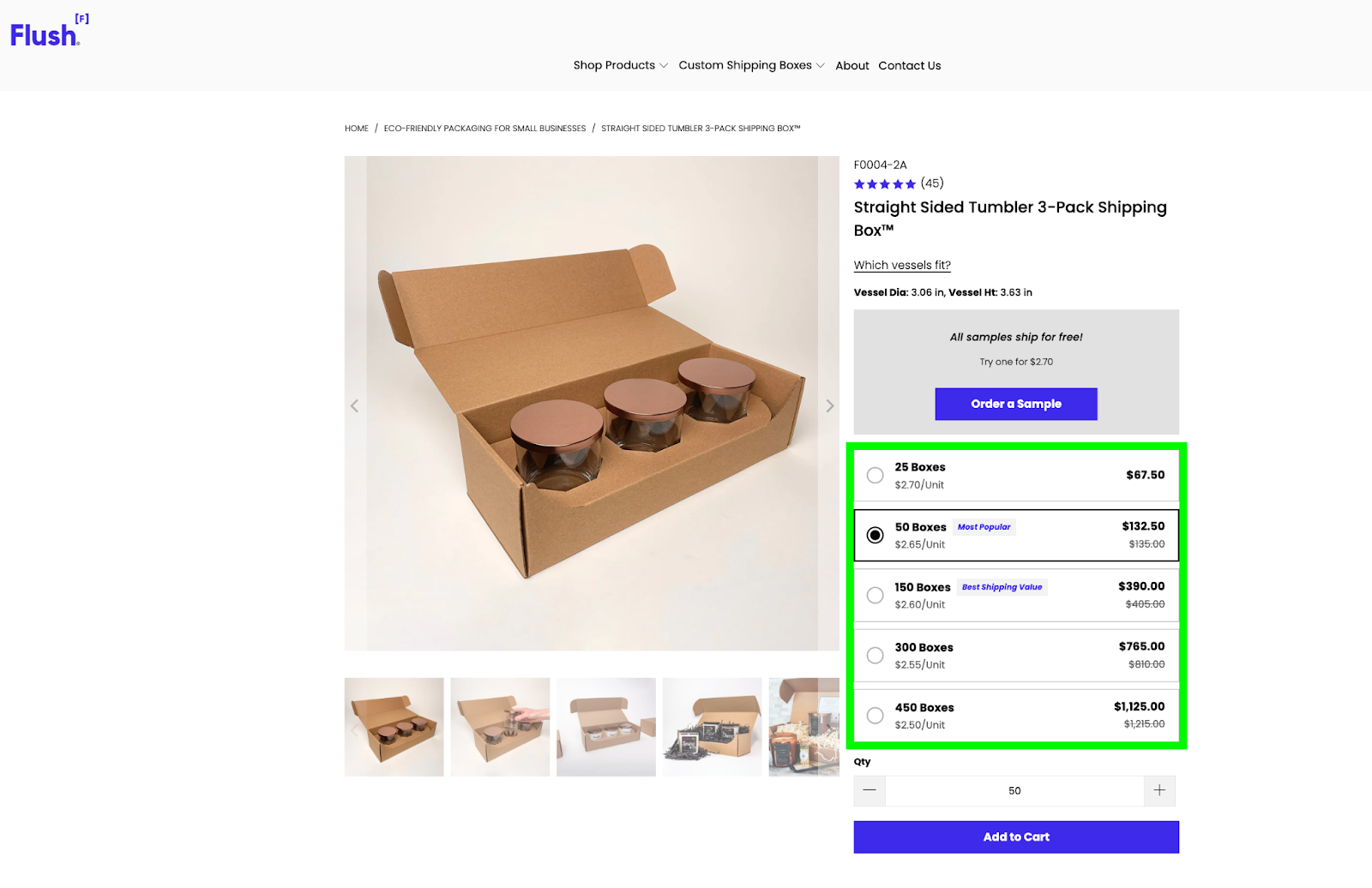
18. Display free shipping thresholds prominently
Did you know that 62% of online shoppers won’t buy from a store without free shipping? It helps to let visitors know they earn free shipping after reaching the minimum spend. Use website banners, progress bars, or pop-ups to keep the threshold in full view. Allbirds displays its free shipping threshold at the top of all relevant pages.

19. Use urgency (low stock, countdown timers) responsibly
Creating urgency and scarcity will motivate people to take action on your site. You have to give them the sense that they’re running out of time. Udemy is famous for offering time-sensitive flash sales.

Whether it's limited-time discounts or low stock levels, your offer must convey incredible urgency. Here are some ethical practices that leverage FOMO (fear of missing out) in humans:
- Flash sales accompanied by visible countdown timers
- Pre-order discounts
- Low stock alerts
- Limited-time coupon codes
20. Implement loyalty programs and referral rewards
Loyalty and referral programs help create a sense of community, leading to emotional connections, increased brand trust, and better conversion rates. Use loyalty programs to encourage repeat purchases and referral rewards to drive revenue growth. In fact, there are ways to combine both programs into one, as shown below.

Real estate SaaS company RealtyNinja launched a double-sided referral program that had a conversion rate that was double that of paid ads.
E. Marketing & Conversion Triggers
21. Run A/B tests on CTAs, headlines, and hero banners
To maximize conversion rate, you need to publish the best versions of your marketing elements. A/B testing, also known as split testing, is a method of comparing two versions of a digital asset to see which one performs better. Half of your visitors see one version and the other half see another, as shown by AbProfit.

You can run A/B tests for your offers, web content, product images, designs, and more. However, always restrict the differences between versions A (control) and B (variant) to one element (CTA, headline, button placement, etc.). Use a tool like Optimizely or Kaching Quantity Breaks (for bundles) that allows you to run A/B testing and analyze individual performance.
Test the following elements for a better conversion rate:
- Headlines
- CTA
- Pricing
- Hero banners
- Product descriptions
- Images
- Page layouts
- Bundle offers
- Videos
- Button designs and placement
22. Use retargeting ads for cart abandoners & product viewers
Ad retargeting allows you to display new ads to users who have previously interacted with your brand. That makes it an effective tool for engaging cart abandoners and people who have previously viewed your product.
Automotive manufacturer Mazda boosted conversion rate by more than half using smart PPC ads. The ad showed the specific Mazda models that site visitors were interested in by leveraging their website activity.
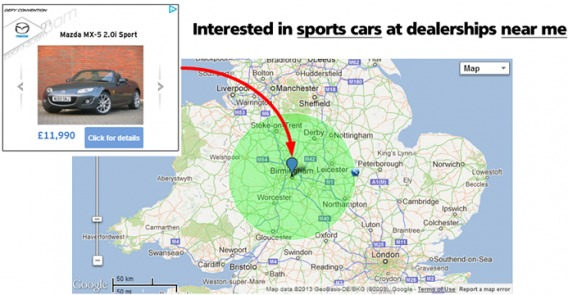
23. Add live chat or AI chatbots to answer pre-purchase questions
Customer satisfaction is key to successful conversions. One way to keep visitors happy is to provide a way for them to get answers in real time. Integrate live chat or AI chatbots throughout your site, including checkout, to address concerns and answer questions instantly.
For example, the handcrafted leather sneaker label THEY New York used conversational AI to reduce storefront abandonment and boost conversions.

If you want to implement a similar strategy, below are helpful tips to remember.
- Choose a reliable AI chatbot tool or use Shopify Inbox app to build your own knowledgebase for customer chat
- Train the AI with every detail about your store
- Regularly update its knowledge base
- Ensure the display the chatbot option remains visible at checkout
24. Personalize landing pages by audience/traffic source
Personalized pages let you adapt content, offers, and designs to certain types of visitors. One simple, yet effective, piece of visitor data to consider is traffic source. A traffic source is the channel or platform through which a user accesses your site.
A visitor coming from a Facebook ad will have different motivations and interests from one coming from an email newsletter. Hence, they may require different approaches for successful conversion.
Zola’s personalized home pages saw 5% to 20% higher conversion rates compared to more generic pages. A key factor was the traffic coming from social media platforms like Pinterest.

25. Optimize email/SMS flows (welcome, post-purchase, win-back) for conversion
One final way to improve Shopify conversion rate is to set up automated email or SMS flows. When done right, they work great for customer engagement and retention.
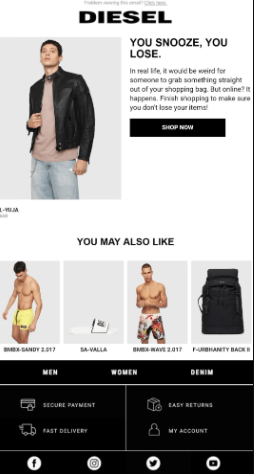
The following are ways to optimize each type of email/SMS flow:
- Welcome: These tend to have the highest open rate, so you want to turn readers into customers immediately. Offer a small discount on their first purchase.
- Post-purchase: Delay sending these messages until they have had the chance to use the product. Gather customer feedback to inform your decisions by asking for an honest review or survey.
- Win-back and cart recovery: Send the first message 1-2 hours after they abandon their carts, and offer an incentive (discount) to get them back on track. CTA is vital here, so test different variations.
Omniconvert posted a list of conversion-optimized email samples you can use as inspiration for your campaign.
Shopify CRO: Final Tips and Takeaways
Analyze your existing site data and decide on which strategies to choose. You have 25 solid options in the section about how to increase Shopify conversion rate.
Remember that you may need to install new plugins to implement some of the tactics I mentioned. I strongly recommend that you prioritize apps that offer free trials and A/B testing. That way, you can find your most effective strategies before you commit to long-term subscriptions.
Start optimizing your Shopify store today!

Start your 14-day free trial
Join over 28,000+ merchants already growing with Kaching Appz®.

